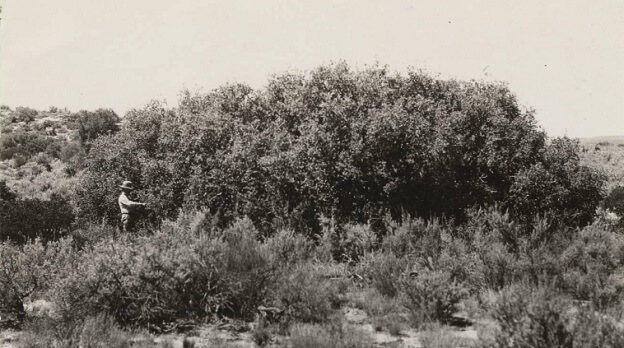
A Palmer's Oak (Quercus palmeri), photographed in 1931, representing the same type of tree as the Jurunga Oak.
Image from Wieslander Vegetation Type Mapping Collection, courtesy of Marian Koshland Bioscience & Natural Resources Library, Univ. of California, Berkeley.
The Los Angeles Almanac has never before featured a subject outside the boundaries of Los Angeles County. However, because this concerns a local Native American tribal group and the subject is an extraordinary ancient living organism in our Southern California neighborhood, we thought to make this exception.
The Gabrieleño Band of Mission Indians-Kizh Nation has sought protection for an ancient oak tree in the Jurupa Hills of Riverside County that is endangered by housing development. Commonly called the Jurupa Oak, the Kizh call it the Hurungna Oak (so named for a Gabrieleño village that once was located nearby). Oak trees are considered sacred in California native culture, but this one is also extraordinary due to its age. The tree has been scientifically determined to be at least 13,000 years old, making it not only the oldest known living organism in California and second oldest in North America, but, the third oldest living organism on earth.
The Jurupa Oak is a Palmer’s Oak (Querus Palmeri), a variety normally found in more mountainous, cooler and wetter locations than the northwest corner of Riverside County. The species is categorized as "Near Threatened" by the International Union for Conservation of Nature (considered threatened with extinction in the near future, but not yet qualified for threatened status). After the existence of the Jurupa Oak was accidentally rediscovered, a team of botanists from the University of California, Riverside, and University of California, Davis, conducted a study of the tree. They published their findings in a 2009 article in the scientific journal PLOS ONE, concluding that the tree sprouted from a single acorn in excess of 13,000 years ago. Given that, when this tree first sprouted, Ice Age animals, such as mammoths, giant sloths, and saber-toothed cats still roamed Southern California and humans, beginning to appear in California, hadn't even yet developed agriculture anywhere in the world and were just beginning to domesticate animals.

A mural at the La Brea Tar Pits & Museum in Los Angeles, depicting a scene from Southern California's ice age. Image may be subject to copyright.
The Jurupa Oak is located in the easternmost borderlands of historic Gabrieleño tribal territory. As do all original native peoples in California, the Gabrieleño celebrate oak trees as culturally significant and sacred, calling the tree the “staff of life.” Meal ground from oak acorns was vital in the native diet and feasts were held to celebrate oak trees. Gabrieleño descendants believe that their ancestors would have long revered and celebrated the ancient Jurupa Oak. In 2018, the Kizh Nation tribal group applied for recognition of the Jurupa Oak as a sacred site with the California Native American Heritage Commission.

A mural at the Mary Vagle Nature Center in Fontana, California, depicting a long ago scene of a Gabrieleño settlement. Image may be subject to copyright.
Today, the region around the Jurupa Oak is experiencing rapid growth. The undeveloped land upon which the tree lives faces adjacent residential and commercial development. Any nearby construction, without a clear determination of its impact on the ecological system that sustains the tree, poses a high risk of killing one of the most ancient living things on the planet.
The Gabrieleño people hope to draw the interest of the public and public officials to support the protection and preservation of the ancient Jurupa Oak. Until it can be protected, its specific location is not revealed so as to try to prevent the risk of vandalism and souvenir hunters.

Leaves of a Palmer's Oak (Quercus palmeri). Image courtesy of Tentaculatta, via Wikimedia Commons.
Also see: California’s Oldest Tree May Be Threatened by Proposed Riverside County Development, L.A. Times, Nov. 6, 2023.